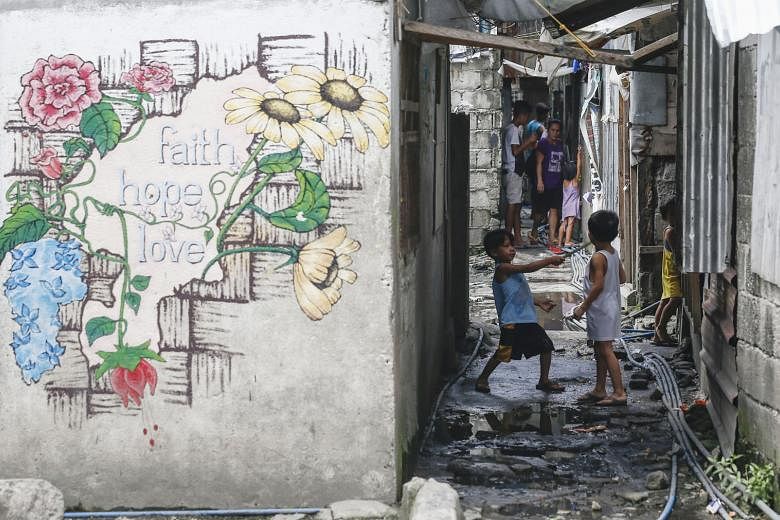East Asia and the Pacific are now home to the largest slum population in the world, as the region's cities grow at a rapid pace, bringing with it the blights that go with urban sprawl.
More than 250 million people live in slums in China, Indonesia, the Philippines and elsewhere in East Asia, and in the small island states that dot the Pacific, according to the World Bank's latest report on urban poverty, released yesterday.
That surpasses Sub-Saharan Africa's 200 million, and South Asia's 191 million.
Conditions in these settlements are dismal, with settlers living in overcrowded colonies with little or no access to tap water, electricity, sewage disposal, public transportation and affordable housing.
Slums "mark the sites of deprivation and exclusion (monetary, infrastructural, social, and political) within the urban built environment" and "signal a trend towards the urbanisation of poverty", the World Bank said in its report.
Slum populations have exploded along with rapid urban growth in East Asia and the Pacific. The region is home to 1.2 billion slum dwellers - or one in every three of the world's city dwellers - and the rate is growing at 3 per cent a year. Chinese cities alone have seen a population increase of 130 million from 2000 to 2010, with most of the people ending up in slums.
Half of the population in China, Indonesia, Malaysia and the Philippines now live in cities.
-
Urban poor most vulnerable to disasters, economic shocks
-
Each year, millions of people flock to East Asia's fast-rising cities to claim their share of prosperity there.
Yet, while many find opportunities, they also end up in places where they are vulnerable to typhoons, floods, epidemics and sudden economic downturns.
The urban poor are often the most vulnerable to natural disasters and climate change, as most of them cannot afford proper housing and have to live in high-risk locations such as hillsides and flood-prone areas on the banks of rivers or canals.
In Jakarta, the poor are more likely to be concentrated in flood-prone informal settlements in the north and north-eastern parts of the city, in areas such as Waduk Pluit, which is said to house more than 70,000 people.
East Asia and the Pacific experience 70 per cent of the world's natural disasters.
Six out of the 10 cities most vulnerable to coastal flooding due to sea level rise and storm surge are in the region, many of them economic hubs such as Guangzhou, Shanghai, Bangkok and Ho Chi Minh City.
Because they disrupt work and production, natural disasters have a disproportionate effect on the urban poor, who rely on cash incomes from work to stay afloat in the urban economy.
In 2011, one of the most expensive years on record, losses due to natural disasters totalled US$259 billion (S$352 billion).
With little access to healthcare, the urban poor also suffer the most from epidemics like the 2003 outbreak of the Sars virus.
Economic shocks like the 2008-2009 global financial crisis, meanwhile, can have an even more dire impact.
In the Philippines, the economic crisis resulted in an additional 1.4 million people living below the poverty line.
During an earlier period of financial collapse, Indonesia saw a significant increase in urban poverty from 5 per cent in 1996 to 8.3 per cent in 1998.
Raul Dancel
While urban growth has helped lift about 655 million out of poverty in East Asia and the Pacific in 20 years, it has also led to widening inequality. The impact is felt most in slums where basic services are almost non-existent.
In Indonesia's Yogyakarta, slum dwellers in the so-called grey economy make about US$82 (S$112) a month, against US$216 for those in the formal sector.
Poor sanitation in Jakarta's slums has led to a higher risk of water contamination, water-borne diseases and disability. One study reported 342 diarrhoea cases out of every 1,000 inhabitants at one squatter colony, and an infection rate of 43 per cent in children with at least one type of intestinal worm.
In Cambodia and Thailand, home-based workers labour in dark, hot, windowless rooms because they choose not to use electric fans or lights to save on utility bills.
Most roads in slums are without sidewalks and are too narrow for larger public transport vehicles. This means costly and lengthy commutes to workplaces.
Transport policies, which mostly involve traffic rerouting and building of more roads, are seen as car-oriented and anti-poor. Many cities are also banning means of transportation favoured by the poor - rickshaws in Jakarta and trishaws in Wuhan, China.
Housing remains a pipe dream for a majority of slum dwellers, due to soaring prices, high demand and lack of access to credit. A 2013 housing survey estimated a housing backlog in Indonesia of 11.8 million units, with 820,000 to 920,000 required in urban areas annually.
Restrictive land-use policies also work against slum dwellers. In Vietnam, property ownership is restricted to those with urban residency status, which bestows a "right to the city" privilege that includes access to health and education services.
The World Bank said governments need to revise policies to connect the urban poor to better-paying, more secure jobs, and open lending opportunities to them. And while micro-enterprises fill the gap, they are often targeted at specific communities or areas rather than the urban poor more broadly.
Nations also have to invest in clean water, sanitation and solid waste management, as these have an impact on health, productivity and welfare, it said.
"Cities across East Asia have propelled the region's tremendous growth. Our collective challenge is to expand opportunities to all in the cities, from new migrants living on the periphery to factory workers struggling to pay rent, so that they can benefit more from urbanisation and help fuel even stronger growth," said Ms Victoria Kwakwa, the World Bank's vice-president for East Asia and the Pacific.


